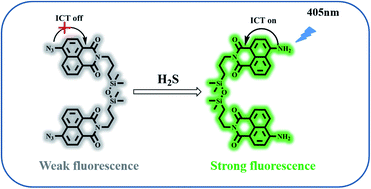An ICT-based fluorescent probe with bridging Si–O–Si bonds for visualizing hydrogen sulfide in lipid droplets and its application†
Abstract
Hydrogen sulfide (H2S) is considered as an important endogenous gaseous signaling molecule in biological systems. It plays a significant role in various intracellular activities. Therefore, it remains an urgent task to develop a new simple and efficient pathway for effective detection of H2S in biological systems. Here, a novel fluorescent probe (named H-LDS) was designed and constructed. H-LDS based on naphthalimide derivatives and small molecule organosilicone localizes lipid droplets. H-LDS also shows excellent selectivity and high sensitivity for H2S both in vivo and in vitro. The reaction mechanism of H-LDS is based on the intramolecular charge transfer (ICT) mechanism. H-LDS has been successfully applied to localize lipid droplets and detect exogenous H2S in HeLa cells. Our work clarifies the potential applications of small molecule organosilicone fluorescent probes in biological systems.



 Please wait while we load your content...
Please wait while we load your content...